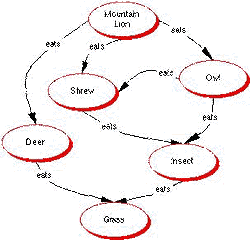Residents:
The Species of the Mediterranean and Their Food Web.

Mediterranean Chaparral Food Web
The creatures that inhabit the Mediterranean shrublands are both diverse and specialized to the region. The distinctive climate allows for certain species of plants and animals to flourish. The primary vegetation in the area is, you guessed it, shrubs. Some of the said shrubs include evergrees schrubs which include holm oak, ree heath, strawberry tree, sage, juniper, buckthorn, spurge olive, and myrtle. Other vegetation in the biome region is larger trees, hard leaf forests, aromatic plants, such as rosemary and thyme and vegetation that is drought resistant like evergreens, cork oak, and cacti. Plants with small hard needles and plants with small leathery leaves are imperative components to the ecosystem. These are the producers of the biome.
WIldlife in the area consists of wild goats, sheep, cattle, mouflon, rabbits, horses, lynx, wild boar, vultures, eagles, Apennine wolf, beech-marten, deer, black stork, black vulture, dormouse, Egyptian mongoose, great bustard, hare, hedgehog, Iberian lynx, Spanish Imperial eagle, weasel, wild boar, wild goat, wild sheep as well as a variety of reptiles and insects as consumers.
Different species of fungi and bacteria are decomposers in the region.
WIldlife in the area consists of wild goats, sheep, cattle, mouflon, rabbits, horses, lynx, wild boar, vultures, eagles, Apennine wolf, beech-marten, deer, black stork, black vulture, dormouse, Egyptian mongoose, great bustard, hare, hedgehog, Iberian lynx, Spanish Imperial eagle, weasel, wild boar, wild goat, wild sheep as well as a variety of reptiles and insects as consumers.
Different species of fungi and bacteria are decomposers in the region.
What are We?
The producer in the Mediterranean shrublands is primarily various grasses. While consumers are basically everything else, other than the decomposers, which are fungi and bacteria. The herbivores in the shrublands are those who eat only the grasses, such as the deer, rabbits, goats and insects. The carnivores eat the herbivores in the region. Those animals are the shrew, mongoose, owl, and beech marten among others. The top carnivores are the mountain lion, Iberian lynx, and Apennine wolf because they are animals that have no others using them as a source of food, and it can eat basically anything throughout the web.
What do we Do?
In an ecosystem producers consumers and decomposers all play an intrinsic role, particularly to the carbon and nitrogen cycle. The producers in the Mediterranean Shrublands, and in all biomes for that matter, take in energy from the sun. They use this energy to thrive and to produce nutrients for themselves. The next step of the cycle is where the consumers come into play. The consumers eat producers and even other consumers to obtain energy and nutrients. Each tier of this food web and pyramid is known as a trophic level. At each trophic level, aroung 10 percent of the energy from the previous level is passed on. Because of this species at lower trophic levels contain more energy than those at higher trophic levels. When consumers and producers die, their bodies decay and their nutrients are returned to the soil with the help of decomposers. Due to decomposers, soils can become nutrient rich and these nutrients can be transferred back to the producers through their roots. Due to the individual roles of produucers consumers and decomposers, nutrients and energy can efficiently flow through an ecosystem.
